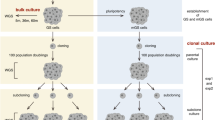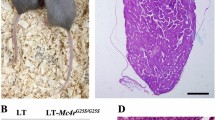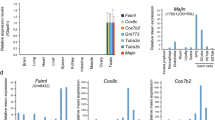Abstract
Disrupting genes in the rat on a genome-wide scale will allow the investigation of many biological processes linked to human health. Here we used transposon-mediated mutagenesis to knock out genes in rat spermatogonial stem cells. Given the capacity of the testis to support spermatogenesis from thousands of transplanted, genetically manipulated spermatogonia, this approach paves a way for high-throughput functional genomic studies in the laboratory rat.
This is a preview of subscription content, access via your institution
Access options
Subscribe to this journal
Receive 12 print issues and online access
$259.00 per year
only $21.58 per issue
Buy this article
- Purchase on Springer Link
- Instant access to full article PDF
Prices may be subject to local taxes which are calculated during checkout


Similar content being viewed by others
References
Capecchi, M.R. Nat. Rev. Genet. 6, 507–512 (2005).
Hamra, F.K. et al. Proc. Natl. Acad. Sci. USA 102, 17430–17435 (2005).
Ryu, B.Y., Kubota, H., Avarbock, M.R. & Brinster, R.L. Proc. Natl. Acad. Sci. USA 102, 14302–14307 (2005).
Buehr, M. et al. Cell 135, 1287–1298 (2008).
Li, P. et al. Cell 135, 1299–1310 (2008).
Orwig, K.E., Shinohara, T., Avarbock, M.R. & Brinster, R.L. Biol. Reprod. 66, 944–949 (2002).
Hamra, F.K. et al. Proc. Natl. Acad. Sci. USA 99, 14931–14936 (2002).
Ivics, Z. et al. Nat. Methods 6, 415–422 (2009).
Ivics, Z., Hackett, P.B., Plasterk, R.H. & Izsvak, Z. Cell 91, 501–510 (1997).
Kitada, K. et al. Nat. Methods 4, 131–133 (2007).
Lu, B. et al. Mamm. Genome 18, 338–346 (2007).
Horie, K. et al. Proc. Natl. Acad. Sci. USA 98, 9191–9196 (2001).
Dupuy, A.J., Fritz, S. & Largaespada, D.A. Genesis 30, 82–88 (2001).
Richardson, T.E., Chapman, K.M., Dann, C.T., Hammer, R.E. & Hamra, F.K. PLoS One 4, e6308 (2009).
Mates, L., Izsvak, Z. & Ivics, Z. Genome Biol. 8 (Suppl. 1), S1 (2007).
Wu, Z. et al. Biol. Reprod. 81, 77–86 (2009).
Cronkhite, J.T. et al. Dev. Biol. 284, 171–183 (2005).
Dann, C.T., Alvarado, A.L., Hammer, R.E. & Garbers, D.L. Proc. Natl. Acad. Sci. USA 103, 11246–11251 (2006).
Hamra, F.K. et al. Dev. Biol. 269, 393–410 (2004).
Vigdal, T.J., Kaufman, C.D., Izsvak, Z., Voytas, D.F. & Ivics, Z. J. Mol. Biol. 323, 441–452 (2002).
Schnutgen, F. et al. Proc. Natl. Acad. Sci. USA 102, 7221–7226 (2005).
Friedrich, G. & Soriano, P. Genes Dev. 5, 1513–1523 (1991).
Izsvak, Z. et al. J. Biol. Chem. 277, 34581–34588 (2002).
Sanes, J.R., Rubenstein, J.L. & Nicolas, J.F. EMBO J. 5, 3133–3142 (1986).
Acknowledgements
We thank T. Nguyen, T.E. Richardson, G. Mendrano and L.M. Thompson for help with these studies, N. Hübner, D.J. Mangelsdorf and M.H. Cobb for discussions and for critical reading of the manuscript, and EURATools–EURATrans consortium for sponsoring Z. Izsvák and F.K.H to attend annual meetings (grant HEALTH-F4-2010-241504). This work was supported by US National Institutes of Health grants R21RR023958 from the National Center for Research Resources and RO1HD036022 from the National Institute of Child Health and Human Development to F.K.H., by the Bundesministerium fur Bildung und Forschung (grant NGFN-2) to Z. Ivics, European Young Investigator award to Z. Izsvák and by the Cecil H. and Ida Green Center for Reproductive Biology Sciences at University of Texas Southwestern Medical Center in Dallas.
Author information
Authors and Affiliations
Contributions
I.G., J.F., H.M.P., J.R.S., K.M.C. and F.K.H. performed the research; Z. Izsvák, Z. Ivics and F.K.H. designed research; all authors analyzed the data; Z. Izsvák, Z. Ivics and F.K.H. wrote the manuscript. Correspondence should be addressed to F.K.H. regarding spermatogonial technology or Z. Ivics regarding transposon technology.
Corresponding authors
Ethics declarations
Competing interests
The authors declare no competing financial interests.
Supplementary information
Supplementary Text and Figures
Supplementary Figures 1–8, Supplementary Tables 1–5 and Supplementary Discussion (PDF 2237 kb)
Rights and permissions
About this article
Cite this article
Izsvák, Z., Fröhlich, J., Grabundzija, I. et al. Generating knockout rats by transposon mutagenesis in spermatogonial stem cells. Nat Methods 7, 443–445 (2010). https://doi.org/10.1038/nmeth.1461
Received:
Accepted:
Published:
Issue Date:
DOI: https://doi.org/10.1038/nmeth.1461
This article is cited by
-
GSG1L-containing AMPA receptor complexes are defined by their spatiotemporal expression, native interactome and allosteric sites
Nature Communications (2023)
-
Application of genome editing technologies in rats for human disease models
Journal of Human Genetics (2018)
-
Generation of genetically-engineered animals using engineered endonucleases
Archives of Pharmacal Research (2018)
-
Long-term propagation of tree shrew spermatogonial stem cells in culture and successful generation of transgenic offspring
Cell Research (2017)
-
From engineering to editing the rat genome
Mammalian Genome (2017)



